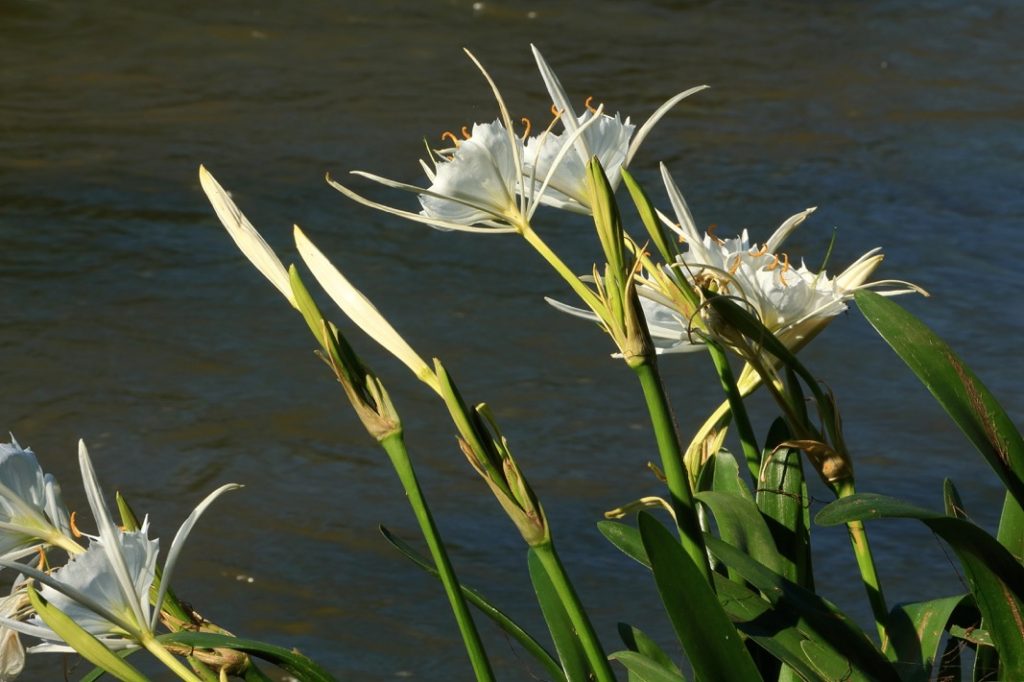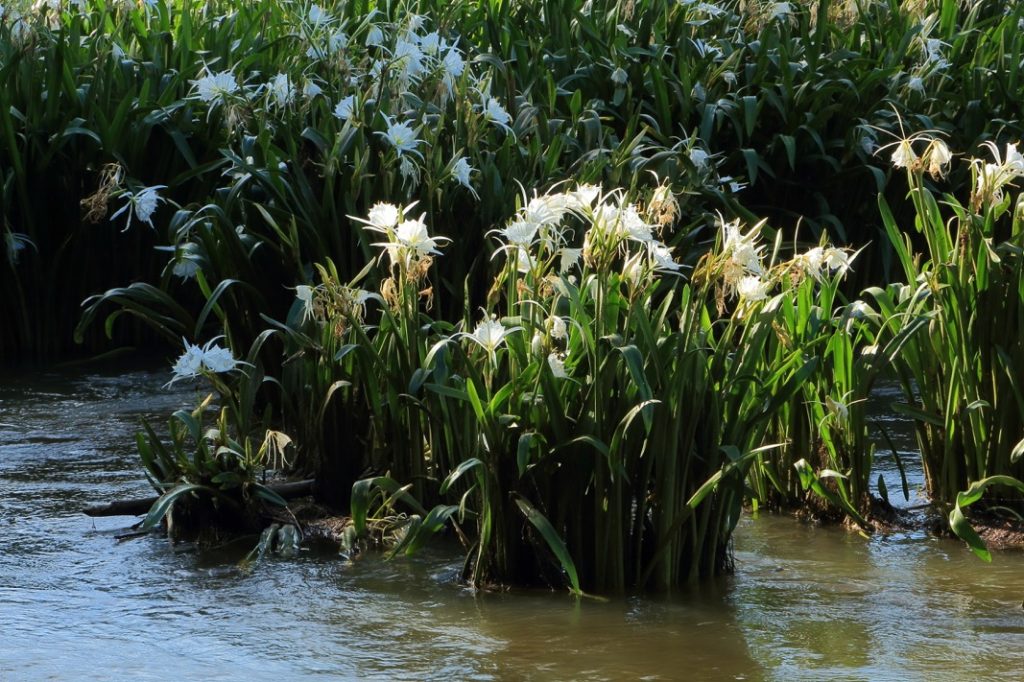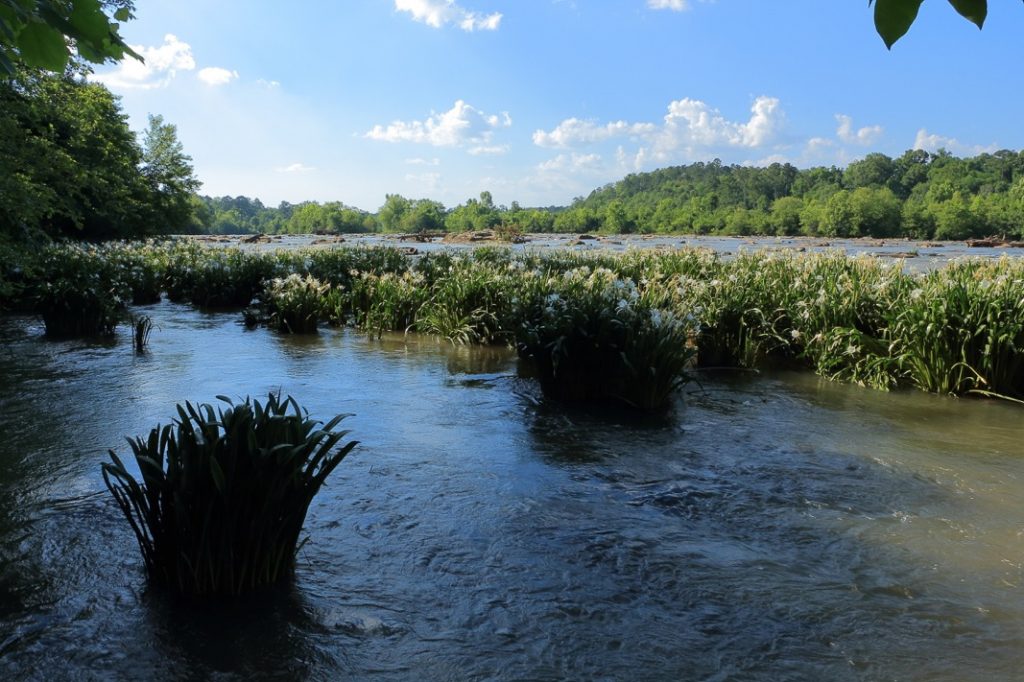A Rare Spectacle
May 30, 2019By Tom Poland
Few people see them. Outside naturalists, conservationists, a few artists, photographers, and writers, most people don’t even know they exist. William Bartram discovered them in his 18th century visit to the Savannah River—Rocky shoals spider lilies, a wondrous plant with deep green stems and snow-white blooms. What gorgeous flowers. What a spectacle. A botanist will refer to them as Hymenocallis coronaria. Other names include Cahaba lily, shoal lily, or shoals spider lily. It’s an aquatic, perennial flowering plant species unique to the Southeastern United States. “Endemic,” say botanists.

Our grandiose schemes to control rivers tried to destroy them all but failed. The lilies survive in a few rocky rivers in the lower Piedmont where their bulbs hitchhiked downstream, lodged in rock crevices, and, in time, established colonies that take your mind off worries come May and June. Well, the bulbs can’t do that so easily now. We erected dams, sullied water, and built man stuff on rivers such that this gorgeous plant is under consideration as an endangered species. Oily boats, chunky water skiers, and polarized-sunshaded fishermen skim over places where rocky shoals spider lilies once flourished, but you can still find them … if you’re adventurous.
Give that some thought. To see rocky shoals spider lilies in bloom is to see a rare spectacle. You see what this country looked like before the Europeans arrived. I beheld them and their great gathering of life. Swallows darted over and through them. Canada geese soared over them, and a hummingbird flew up to one blossom only to flit away before this startled photographer tripped the shutter.

You’ll only find these beauties in Alabama, Georgia, South Carolina, and North Carolina. Around these parts, you can see natural colonies in three locations: Lansford Canal in Chester County, Stevens Creek in McCormick County, and Anthony Shoals in the Wilkes, Elbert, Lincoln County, Georgia region. Mark your calendar for an adventure next spring. The flowers are rare and they only bloom a short while. It is, indeed, a rare spectacle.
For me, Anthony Shoals is personal. Two dams failed to drown it, and so it flutes, froths, and runs white, green, and blue no more than ten minutes from where Mom grew up. Fly as the crow does and it’s three minutes. Mom spoke often of the shoals with a gleam in her eye, and she and Dad took me there as a boy. I recall expanses of water studded by rocks, rocky shoals that take their name from Mom’s relatives. Thus does my daughter, Becky, get her middle name, “Rebecca Anthony Korom.”

For five winters now, I have sworn I would make it to Anthony Shoals come spring. Time, miles, and geography always denied me. Not this year. Deadlines, distance, meetings, projects, rough roads, muddy wallows, fallen logs, vines, and slippery rocks couldn’t stop me. On a beautiful day in May descending a steep bluff, hanging onto trees for support, camera gear over my shoulder, I heard a Chattooga-like roar … down closer to the tumult I went and through the dense greenery of hardwoods, I caught a glimpse of snow-white blooms bobbing and weaving with the current. I know what Sir Edmund Hillary must have felt on his special day in May in 1953. I had reached the summit.
Visit Tom Poland’s website at www.tompoland.net
Email Tom about most anything. [email protected]
Tom’s work appears in publications throughout the South. His books include South Carolina Country Roads, Classic Carolina Road Trips From Columbia, Georgialina, A Southland, As We Knew It, and Reflections of South Carolina, Vol. II. He writes about the South, its people, traditions, lifestyle, and culture. He’s member of the SC Humanities Speaker’s Bureau. Governor Henry McMaster conferred the Order of the Palmetto upon Tom for his body of work on South Carolina. Tom grew up in Lincoln County, Georgia, and graduated from the University of Georgia. He lives in Irmo, South Carolina.



















